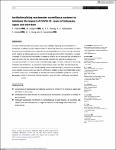Search
Author
- Quan-Hoang Vuong (27)
- Anh-Tuan Le (17)
- Vuong QH (12)
- Anh D. Phan (11)
- next >
Subject
- Electrospinning (8)
- Nanoparticles (6)
- Compound droplet (5)
- Machine learning (5)
- next >
Date issued
- 2020 - 2022 (482)
- 2010 - 2019 (19)
- 2002 - 2009 (1)
Has File(s)
Search Results
Vietnam is among the few countries that were successful in the fight against the first wave of coronavirus disease 2019 (COVID-19). However, subsequent domestic outbreaks of COVID-19 continue to occur. To sharp the community education program to guarantee |
This study reports a scalable green electrochemical synthesis of novel biogenic silver nanoparticles colloid (biogenic AgNPs) in large scale up to 5 liters using the bulk silver bar and the green tea leaves (Camellia sinensis) extract (GTE) as reducing ag |
Sustainability requires that once reservoirs are built, they should be managed as environmentally friendly as possible. If the management policy does not achieve efficiency, there might be a man-made disaster occurred. There is a need for establishing a national strategy for developing hydrological forecasting techniques. In this study, hydrological models MARINE and SWAT were established for the Ban-Chat reservoir basin by testing performance in simulating hourly inflow during flood season for short term forecast and daily inflow for long term management respectively. Both models are set up using the same available database but they differ in terms of spatial discretization, infiltration and water redistribution representation and river flow transfer. Overall, it is argued that MAR... |
Wire-cut electrical discharge machining (WEDM) process is a proficient operation for the precise manufacturing of complex profiles of difficult-to-cut materials. The purpose of the current paper is to determine optimal processing inputs, including the WED |
This mini review describes the current status and challenges regarding institutionalisation of wastewater surveillance systems against COVID-19. Monitoring SARS-CoV-2 in wastewater has been proposed to be a potential tool to understand the actual prevalence of COVID-19 in the community, and it could be an effective approach to monitor the trend during the COVID-19 pandemic. However, challenges to institutionalise wastewater surveillance systems are still abundant and unfolding at a rapid rate given that the international understanding regarding the scientific knowledge and socio-political impacts of COVID-19 are in the developing stages. To better understand the existing challenges and bottlenecks, a comparative study between Japan, Viet Nam, and Indonesia was carried out in the pre... |
In our continuing search for novel small‐molecule anticancer agents, we designedand synthesized a series of novel (E)‐N'‐(3‐allyl‐2‐hydroxy)benzylidene‐2‐(4‐oxoquinazolin‐3(4H)‐yl)acetohydrazides (5), focusing on the modification of sub-stitution in the quinazolin‐4(3H)‐one moiety. The biological evaluation showed thatall 13 designed and synthesized compounds displayed significant cytotoxicity againstthree human cancer cell lines (SW620, colon cancer; PC‐3, prostate cancer; NCI‐H23, lung cancer). The most potent compound5ldisplayed cytotoxicity up to 213‐fold more potent than 5‐fluorouracil and 87‐fold more potent than PAC‐1, the firstprocaspase‐activating compound. Structure–activity relationship analysis revealedthat substitution of either electron‐withdrawing or electron‐releas... |
Compound and simple droplets have been studied and appeared in many life applications, e.g., drug processing and microfluidic systems. Many studies have been conducted on the thermocapillary effects on simple droplets, but similar studies on compound droplets are quite rare. Filling this missing gap, this paper presents the front-tracking-based simulation results of the thermocapillary effects on compound droplets in a certain limited domain. The compound droplet consists of a single inner core that is initially concentric with the outer one. Various dimensionless parameters including Reynolds number from 1 to 50, Marangoni number from 1 to 100, droplet radius ratio from 0.3 to 0.8, and viscosity ratios from 0.1 to 6.4 are varied to reveal their influences on the migration of a comp... |
Haptic devices had known as advanced technology with the goal is creating the experiences of touch by applying forces and motions to the operator based on force feedback. Especially in unmanned aerial vehicle (UAV) applications, the position of the end-effector Falcon haptic sets the velocity command for the UAV. And the operator can feel the experience vibration of the vehicle as to the acceleration or collision with other objects through a forces feedback to the haptic device. In some emergency cases, the haptic can report to the user the dangerous situation of the UAV by changing the position of the end-effector which is be obtained by changing the angle of the motor using the inverse kinematic equation. But this solution may not accurate due to the disturbance of the system. The... |
Modern society has been facing serious health-related problems including food safety, diseases and illness. Hence, it is urgent to develop analysis methods for the detection and control of food contaminants, disease biomarkers and pathogens. As the traditional instrumental methods have several disadvantages, including being time consuming, and having high cost and laborious procedures, optical nanosensors have emerged as promising alternative or complementary approaches to those traditional ones. With the advantages of simple preparation, high surface-to-volume ratio, excellent biocompatibility, and especially, unique optical properties, gold nanoparticles (AuNPs) have been demonstrated as excellent transducers for optical sensing systems. |
Although most Asian states are signatories to UNCLOS, which offers options for dispute resolution by either voluntary or compulsory processes, in reality fewer than a dozen Asian states have taken advantage of such an approach. The decision to adopt third-party mechanisms comes under great scrutiny and deliberation, not least because of the entailing legal procedures and the politically sensitive nature of disputes. Vietnam claims the second-largest maritime area in the South China Sea dispute after China. A comparison of two recent cases—the arbitration between the Philippines and China and the conciliation between Timor-Leste and Australia—highlights the importance of selecting between binding and nonbinding decisions and framing a complaint. In particular, any legal action under ... |






